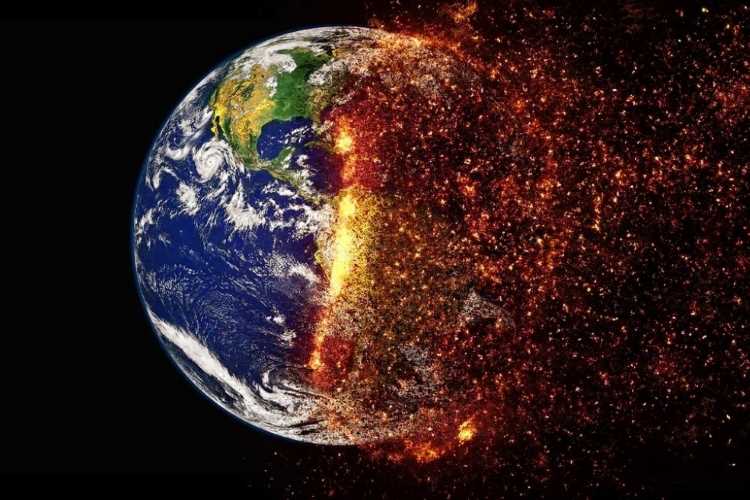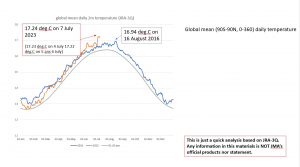
The world recorded the hottest week on record after a record-breaking June marked by soaring sea surface temperatures and alarming Antarctic sea ice decline. The extreme heat levels threaten ecosystems and the environment, underscoring the huge impact of human-induced climate change on earth’s delicate balance.
The sweltering heat witnessed in June and early July coincides with the onset of El Niño, which is expected to exacerbate heatwaves and extreme temperatures on both land and in the oceans, warns Professor Christopher Hewitt, Director of Climate Services, World Meteorological Organisation. Prof. Hewitt’s concern extends into 2024, as he anticipates further records to tumble, painting a bleak future for our planet.
While awaiting confirmation, initial data from the Japanese reanalysis dataset, JRA-3Q, suggests that the global average temperature reached a staggering 17.24 degrees Celsius on July 7th, surpassing the previous record set in 2016 during a strong El Niño year.
READ I Climate change: El Niño’s resurgence spells trouble
Climate change impact
The WMO relies on a combination of satellite observations, reanalysis datasets, and global data from land surface stations and ships to compile its State of the Climate reports. Dr. Omar Baddour, Chief of Climate Monitoring at WMO, underlines the significance of various datasets provided by global partners, indicating new daily temperature records in early July. Vigilantly tracking these climatic shifts across different elements of the climate system and sea surface temperatures is crucial, according to Dr. Baddour.
The European Union’s Copernicus Climate Change Service, collaborating closely with the WMO, reports that June 2023 surpassed the 1991-2020 average by over 0.5°C, shattering the previous record set in 2019. Northwestern Europe endured scorching temperatures, and other regions such as Canada, the United States, Mexico, Asia, and eastern Australia faced significantly hotter conditions. However, some parts of western Australia, western US, and western Russia experienced cooler-than-normal weather conditions.

The Copernicus Climate Change Service highlights the remarkable sea surface temperatures in the North Atlantic, raising substantial concerns. Dr. Michael Sparrow, head of WMO’s World Climate Research Department, expresses alarm at these unprecedented temperatures, exceeding climate model predictions. He underscores the potential ramifications for ecosystems, fisheries, and weather systems.
The heating of the North Atlantic increases the likelihood of more hurricanes and cyclones, as this region triggers several extreme weather events. Additionally, North Atlantic sea surface temperatures influence rainfall patterns in West Africa, leading to heavy rain or drought conditions, showcasing the intricate interconnectedness of global weather systems.
The Copernicus Climate Change monthly report identifies extreme marine heatwaves in Ireland, the United Kingdom, and the Baltic Sea during June. The heat anomaly witnessed in the North Atlantic is caused by a combination of short-term atmospheric circulation anomalies and long-term oceanic changes. El Niño is expected to exert its influence on temperatures later this year and into 2024.
Antarctic sea ice experiences a substantial decline, reaching its lowest extent for June since satellite observations commenced. This decline, 17% below the long-term average, surpasses the previous June record by a significant margin. Throughout June, the daily Antarctic sea ice extent remained low with a loss of 2.6 million square kilometers compared with the satellite era’s long-term average.
Dr. Baddour raises deep concerns about this drastic reduction in Antarctic sea ice extent, emphasizing the profound implications for the region. In contrast, Arctic sea ice extent slightly dips below average but remains higher than the values observed in the past eight years.
Regarding hydrological highlights, the Copernicus Climate Change Service notes that June 2023 witnesses drier conditions than average across much of North America, Russia, the Horn of Africa, most of southern Africa, South America, and parts of Australia. These dry conditions contribute to the occurrence and persistence of severe wildfires. Conversely, southern Europe, western Iceland, northwestern Russia, and other regions experience increased precipitation, resulting in floods.
Scandinavia, central and eastern Europe, and the western coast of the Black Sea are drier-than-average at a time when western North America, southwestern Asia, Japan, South Africa, Brazil, Chile, New Zealand are wetter-than-usual. In June, Japan and Pakistan are hit by typhoon Mawar and cyclone Biparjoy, respectively, illustrating the impact of extreme weather events.
The combination of global warming, high sea temperatures, diminishing sea ice, and shifting precipitation paints an alarming picture. The heat wave and its consequences demand concerted action to address the basic causes of climate change and to mitigate its impact on the planet’s ecosystems, weather patterns, and communities.
